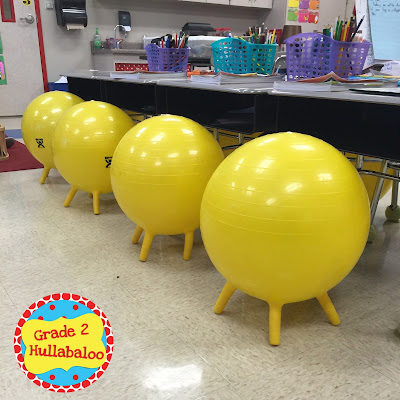Flexible Seating...
It's all the rage! Or is it? Honestly, I am not sure what the current rage is in elementary classrooms (aside from counting down the days until summer break). That moving target, swinging pendulum thingy called educational trends is a slippery sucker. Nevertheless, I am guessing flexible seating would rank in the top ten.
Never being one to jump on the first bandwagon, I pondered the idea for a few months. I thought about how my
Start Small
I already had a few things to allow for some flexibility in seating -- a couple of beanbags and another beanbag-type chair. I also had two upholstered chairs that a family gave me when we opened our new building.
My next purchase was a small mesh and metal stool from At Home. Red, of course! This turned out to be too high for kids to sit on at a desk, and too low for kids to sit on and work anywhere else. So, my TA and I use it to sit by children who need help.
Next, came research on yoga balls. I also looked at Hoki stools, but these really didn't appeal to me. I found Cando exercise balls at Allegro Medical for $9.85 each. Since I was anxious to get them, I spent my own money so that I could put them to use before the end of the school year. I got eight balls for $78.58. In my research, I learned that exercise balls are sized according to height, so I got the 45-inch, yellow balls. These are a perfect size for my second graders.
Establish Rules
We established three rules for the yellow hoppers. Yes, we named the exercise balls. The first was no sharp objects around them. Second, no bouncing. Okay, there was some gentle bouncing in the beginning that I ignored as the children tested them. The smiles on their faces were priceless as they bounced and looked around at their classmates. After everyone had a chance to try them, the no bouncing rule went into full effect. Finally, and this is kind of where my 'can't-stand-grating-noises-sensitivity' comes into play, no screeching. Some children would roll them forward and backward, and they would make this groany-screechy noise that drove me nuts when everyone else was working quietly. Looking forward to next year, I am going to put a carpet under them. I think this will reduce the noise.
You may be surprised to find things in your own home that will work well with flexible seating. I went through my house to see what I had that might work at school. I found a breakfast tray table that I never uses, so off it went to school. It has a flip-up stand to hold a book, and let me tell you, after the initial interest in the yellow hoppers wore off, this was THE most popular workspace choice! I wish had had a few more of these, because they are GREAT!
How many tubs or storage boxes do you have in your classroom? That many? Me, too! Here's one that I covered with a felt tablecloth. I simply hot glued the felt pieces into a pattern and used it as a tablecloth. I used a box of tag board as the flat surface, and covered it with my homemade tablecloth. This was a popular spot. It was the perfect height for little ones to work. I also did the same thing with one of my field trip coolers. I used some leftover fabric and draped it over a flat, cardboard piece for an instant tablecloth! Another popular spot!
Claiming a Spot
I thought this would be the biggest headache of flexible seating. Wouldn't everyone want to sit on the yellow hoppers? As it turned out, all I needed was a system to help the children start the day with everything they needed. The expectation was to unpack first. They had a classwork folder, a POP binder (Perfectly Organized Panther), their handwriting workbook, and their Panther Paw Keeper (PBIS rewards). These were the items they were required to take to their spot for the day. They could only claim a spot once they had these items in hand. So, if someone really wanted a specific spot, he had to hustle to get organized to grab that spot. There were a few times that I sent friends back to get everything they needed, and that resulted in losing a spot.
There was never an argument or power struggle over a seat. I always stressed to "choose a learning spot where you can be the best learner" and this seemed to work. Best buddies didn't flock together just for the sake of chatting more. I was amazed. Interestingly enough, some of my friends tried out the alternative spots, but ultimately went back to traditional desks. I learned a lot about my students' needs and preferences simply by letting them choose. This was the biggest benefit of flexible seating for me.
Kid Choice = Kid Happiness
One Caveat: For some friends with attention challenges or other needs, I did sometimes have to assign a seat. The yellow hoppers were too much because of distractions or physical challenges. The beanbags were used to lounge instead of doing one's best work. We had some talks about how our best buds may not be our best school partners or how a fun seat may not be the best learning seat. The bottom line is that YOU are the boss of the room, and if you feel someone isn't in an optimal spot, YOU get to make the change. My students knew this.
Storage
The second thing that I was afraid would be a nightmare was storage. This one is tricky, because I have LOTS of books and shelves. Therefore, finding extra storage space was a bit of a problem -- albeit a good problem to have! First, we put glue sticks in a basket. We also put zippies of crayons on a basket. Each desk/table area had a basket with cups for scissors, Sharpies, sticky notes and markers. Math books, science notebooks, writing folders, and handwriting workbooks went into baskets stored on a shelf. When it came time to pass out any of these items, I would say, "Odds, grab two math books and share with a friend." This meant that all of the odd-numbered students would grab two math books and take them to their owners. At first, they would sort through to find their own book, but after a few times, they understood that someone would bring their book to them. This worked really well for grabbing scissors, crayons or anything else we needed. I have repurposed a cheap book shelf at home with a pretty coat of ocean blue paint. It will house most of our supplies for this coming year.
Looking Forward
Next year, I'll begin the year with flexible seating. That means I'll have to have a solid plan in place for training my new second graders. Today, three days after school is out, my plan is to assign seats for the first couple of weeks. I'll rotate children to different spots each day. At some point during the day, we'll check-in to see if kids want to switch spots. I am the only teacher in my school who has tried flexible seating, so my sweet second graders' minds are going to be blown when they walk into a room with beanbags, yellow hoppers and laundry baskets (I'm adding a few of these over the summer). Patience and flexibility will be the key for me.
If you have questions, I'll do my best to answer them. If you've tried flexible seating, how did it work for you? Do you have any great finds for seating? Any suggestions for organizing supplies?
Thanks for stopping by to read about my adventure with flexible seating. I hope your year-end countdown is over or very close to over!





Did you order the yellow 18 inch balls for your second graders? You said 45 inch in your post but that option is not available on Cando. Thanks
ReplyDelete